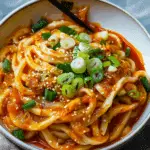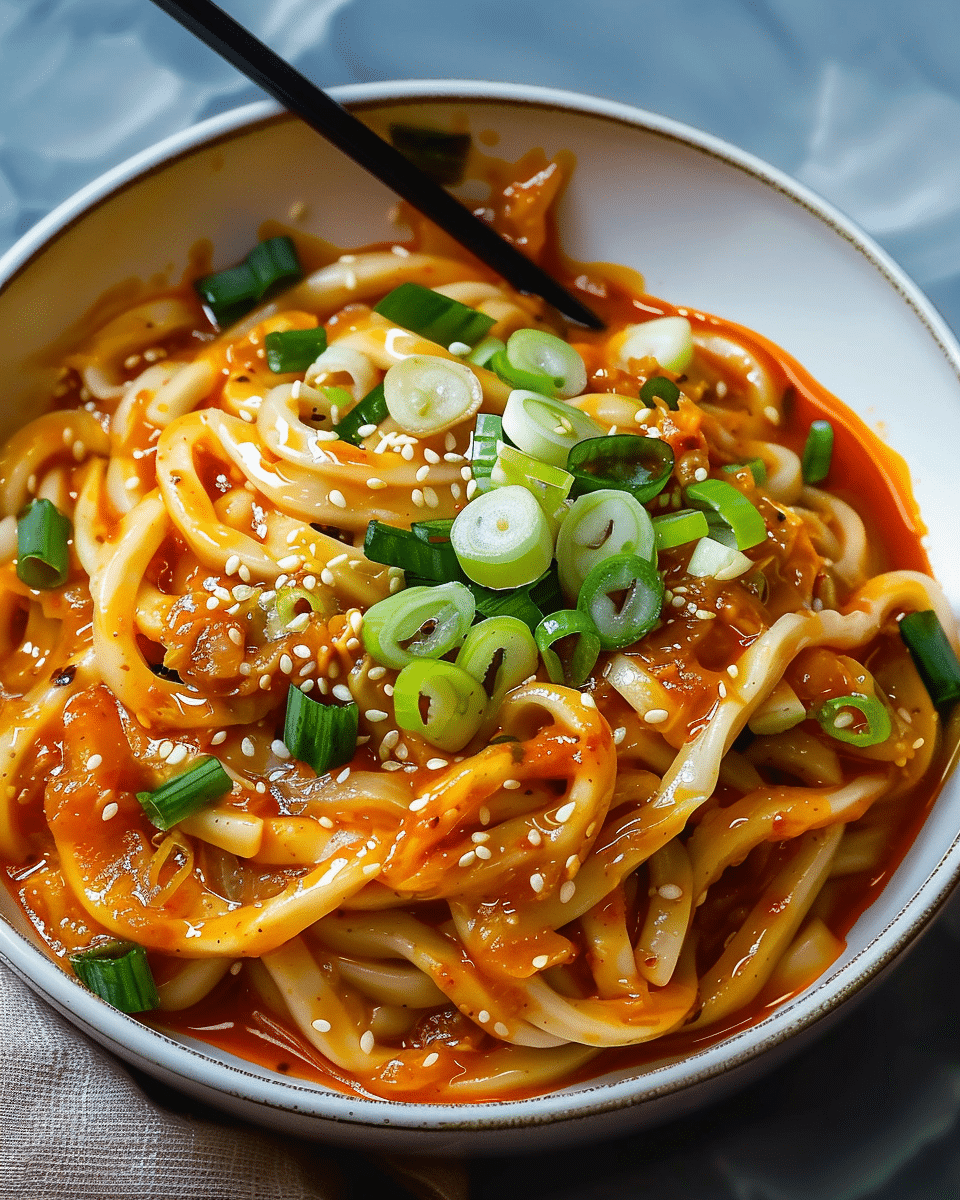Why You’ll Love This Recipe
Kimchi Udon with Scallions combines the heartiness of udon noodles with the spicy kick of gochujang, the sourness of kimchi, and the fresh, crisp bite of scallions. It’s a one-pan meal that’s simple to prepare, yet packed with layers of flavor. The savory vegetable broth ties everything together, while the kimchi adds a punch of umami and the gochujang brings just the right amount of heat. If you’re a fan of Korean-inspired dishes or looking for a quick comfort meal, this is sure to become a go-to recipe.
Ingredients
- 200 grams udon noodles
- 1 cup kimchi, chopped
- 2 tablespoons vegetable oil
- 1 cup scallions, chopped (green parts only)
- 2 cloves garlic, minced
- 1 tablespoon ginger, minced
- 2 tablespoons soy sauce
- 1 tablespoon gochujang (Korean red chili paste)
- 1 cup vegetable broth
- Salt and pepper to taste
- Sesame seeds for garnish (optional)
(Tip: You’ll find the full list of ingredients and measurements in the recipe card below.)
Directions
1. Boil Udon Noodles:
Cook the udon noodles according to package instructions (typically around 6-8 minutes). Drain and set aside.
2. Heat Oil:
In a large skillet or wok, heat the vegetable oil over medium heat.
3. Sauté Aromatics:
Add the minced garlic and ginger to the skillet, sautéing for about 1-2 minutes until fragrant.
4. Add Kimchi:
Stir in the chopped kimchi and cook for about 2-3 minutes until it’s heated through.
5. Add Broth:
Pour in the vegetable broth and bring it to a gentle simmer.
6. Incorporate Udon:
Add the cooked udon noodles to the skillet, stirring gently to blend everything together.
7. Season:
Add the soy sauce and gochujang, mixing thoroughly. Adjust the seasoning with salt and pepper if needed.
8. Add Scallions:
Toss in the chopped scallions and stir to combine. Cook for an additional 2-3 minutes until everything is heated thoroughly.
9. Serve:
Dish out the Kimchi Udon into bowls and sprinkle with sesame seeds if desired.
10. Enjoy:
Serve hot and enjoy the amazing flavors!
Servings and Timing
- Servings: 2-3
- Prep Time: 10 minutes
- Cook Time: 25 minutes
- Total Time: 35 minutes
Variations
- Protein Boost: Add a protein like tofu, chicken, or beef to make this dish more hearty.
- Spicier: If you like your food extra spicy, add more gochujang or some chili flakes to amp up the heat.
- Vegetarian Option: This recipe is vegetarian as it is, but you can substitute vegetable broth with a mushroom broth for more umami.
Storage/Reheating
- Storage: Leftovers can be stored in an airtight container in the fridge for up to 2-3 days.
- Reheating: Reheat in a skillet over medium heat, adding a splash of vegetable broth to loosen up the sauce.
FAQs
1. Can I make this dish without gochujang?
Yes, you can substitute gochujang with Sriracha or any other chili paste. However, gochujang provides a unique depth of flavor, so try to use it for the best results.
2. Can I use other noodles instead of udon?
Yes, you can use ramen noodles, soba, or even rice noodles if udon isn’t available.
3. How do I make the noodles less sticky?
After draining, rinse the udon noodles under cold water to remove excess starch. This will keep them from sticking together.
4. Can I make this recipe ahead of time?
Yes, you can make the kimchi udon ahead of time and store it in the fridge. Reheat on the stove, adding a little extra broth if needed.
5. How do I store leftover kimchi?
Store leftover kimchi in an airtight container in the fridge. It can last for several weeks and its flavor will continue to develop.
6. Can I add more vegetables?
Yes, you can add vegetables like mushrooms, spinach, or bok choy for extra texture and nutrition.
7. Can I make this recipe gluten-free?
To make it gluten-free, simply swap the udon noodles with gluten-free noodles and make sure the soy sauce is tamari or gluten-free.
8. Can I use fresh ginger instead of minced ginger?
Yes, fresh ginger works perfectly. Just mince it finely and add it to the dish for that vibrant, aromatic flavor.
9. How do I make this dish milder?
To reduce the heat, use less gochujang and omit any chili flakes. You can also add a little more soy sauce for balance.
10. How do I know when the kimchi is heated properly?
You’ll know the kimchi is heated when it becomes fragrant and slightly softens but still retains its texture and flavor.
Conclusion
Kimchi Udon with Scallions is the ultimate comfort dish with the perfect combination of spicy, savory, and tangy flavors. It’s easy to make, incredibly satisfying, and can be enjoyed for lunch, dinner, or even as a late-night snack. The richness of the gochujang and kimchi pairs beautifully with the savory broth and noodles, making each bite irresistible. This dish is a must-try for anyone who loves bold, flavorful meals with a kick!

Kimchi Udon with Scallions: An Incredible Ultimate Recipe
- Prep Time: 10 minutes
- Cook Time: 25 minutes
- Total Time: 35 minutes
- Yield: 2-3 servings
- Category: Main Dish
- Method: Stovetop
- Cuisine: Korean-Inspired
- Diet: Vegetarian
Description
Kimchi Udon with Scallions is a quick and flavorful dish combining udon noodles, spicy kimchi, savory broth, and a touch of heat from gochujang. Perfect for a satisfying and bold meal.
Ingredients
For the Falafel:
200 grams udon noodles
1 cup kimchi, chopped
2 tablespoons vegetable oil
1 cup scallions, chopped (green parts only)
2 cloves garlic, minced
1 tablespoon ginger, minced
2 tablespoons soy sauce
1 tablespoon gochujang (Korean red chili paste)
1 cup vegetable broth
Salt and pepper to taste
Sesame seeds for garnish (optional)
Instructions
- Boil Udon Noodles: Cook the udon noodles according to package instructions (typically around 6-8 minutes). Drain and set aside.
- Heat Oil: In a large skillet or wok, heat the vegetable oil over medium heat.
- Sauté Aromatics: Add the minced garlic and ginger to the skillet, sautéing for about 1-2 minutes until fragrant.
- Add Kimchi: Stir in the chopped kimchi and cook for about 2-3 minutes until it’s heated through.
- Add Broth: Pour in the vegetable broth and bring it to a gentle simmer.
- Incorporate Udon: Add the cooked udon noodles to the skillet, stirring gently to blend everything together.
- Season: Add the soy sauce and gochujang, mixing thoroughly. Adjust the seasoning with salt and pepper if needed.
- Add Scallions: Toss in the chopped scallions and stir to combine. Cook for an additional 2-3 minutes until everything is heated thoroughly.
- Serve: Dish out the Kimchi Udon into bowls and sprinkle with sesame seeds if desired.
- Enjoy: Serve hot and enjoy the amazing flavors!
Notes
For a protein boost, add tofu, chicken, or beef to make the dish heartier.
If you prefer a spicier dish, increase the amount of gochujang or add chili flakes.
This recipe is vegetarian, but you can substitute the vegetable broth with mushroom broth for added umami.
For gluten-free, use gluten-free noodles and tamari or gluten-free soy sauce.
Nutrition
- Serving Size: 1 serving
- Calories: 350
- Sugar: 7g
- Sodium: 850mg
- Fat: 14g
- Saturated Fat: 2g
- Unsaturated Fat: 9g
- Trans Fat: 0g
- Carbohydrates: 44g
- Fiber: 5g
- Protein: 8g
- Cholesterol: 0mg



